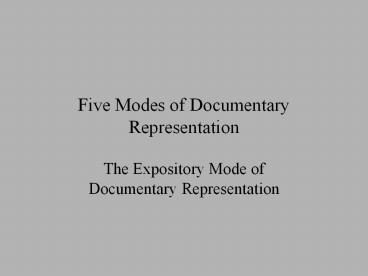Five Modes of Documentary Representation - PowerPoint PPT Presentation
Title:
Five Modes of Documentary Representation
Description:
Five Modes of Documentary Representation The Expository Mode of Documentary Representation Table of Contents 1) General ideas of documentary films 2) Five modes of ... – PowerPoint PPT presentation
Number of Views:387
Avg rating:3.0/5.0
Title: Five Modes of Documentary Representation
1
Five Modes of Documentary Representation
- The Expository Mode of Documentary Representation
2
Table of Contents
- 1) General ideas of documentary films
- 2) Five modes of documentary films
- 3) Expository mode of documentary representation
- 4) Robert Flaherty and his documentaries
- 5) Flaherty and British documentaries
3
General Ideas of Documentary Films
- Documentary a factual film or television
programme about an event, person, etc.,
presenting the facts with little or no fiction. - Documentary A film whose representation of its
subjects that viewers are intended to accept
primarily as factual. A documentary film may
present a story or it may not.
4
General Ideas of Documentary Films
- The positions being questioned
- Documentaries are non-fiction films which are
sharply distinguished from fiction films. The
world depicted in the documentary is real, not
imaginary. - The documentary filmmaker simply observes and
makes an objective record of real events.
5
General Ideas of Documentary Films
- Documentary films do not create but record
reality. - - Consist of raw footage of real people, real
events and real objects. - Truthful reflection of actuality.
6
General Ideas of Documentary Films
- Are Documentary Films True to Their Subjects?
- Joris Ivens (a controversial Dutch documentary
filmmaker) says it is permissible to make up
things in non-fiction movies.
7
General Ideas of Documentary Films
- Filmed in selected mise-en-scène
- Filmed events are ordered and reshaped in
particular montage - NOT RECORDED BUT CONSTRUCTED REALITY
8
General Ideas of Documentary Films
- Documentaries represent events, objects and
people only more truthfully than other types of
films. - Truthfulness and factuality - only relative
concepts - Search for ways in which documentaries represent
actuality as it really is - ? types and schools of documentary filmmaking
9
Five Modes of Documentary Films
- Types of documentary films - - factual film,
ethnographic film, films of exploration,
propaganda film, cinéma vérité, direct cinema
(Richard Barsama) - Expository, observational, interactive,
reflective and performative mode of documentary
representations (Bill Nichols)
10
Expository Mode of Documentary Films
- The expository text addresses the viewer
directly, with titles or voices that advance an
argument about the historical world Expository
texts take shape around commentary directed
toward the viewer images serve as illustration
or counterpoint. Bill Nichols - Voiceover (or subtitles) illustrate story and
image
11
Robert Flaherty and His Documentaries
- Robert Flaherty (1884-1951)
- One of the founding fathers of documentary film
12
Robert Flaherty and His Documentaries
- of course, Moana, 1926 being a visual account
of events in the daily life of a Polynesian youth
and his family, has documentary value. John
Grierson
13
Robert Flaherty and His Documentaries
- Nanook of the North (1922) - about the daily
lives of an Eskimo called Nanook and his family
in the Belcher Islands in arctic Canada
14
Robert Flaherty and His Documentaries
- Flaherty, a prospector, took a movie camera in
his expedition and recorded the unfamiliar
wildlife and people that he encountered. - Lives of the Inuit people
15
Robert Flaherty and His Documentaries
- TRUTH AND FICTION/
- RECORDING AND CONSTRUCTION
- Every scene was planned in advance.
- Discussion between Flaherty and Inuits about
the filming of the walrus hunt. They may have to
give up the kill if it interferes with the film.
The reply yes, yes, the Aggie will come first,
not a man will stir, not a harpoon will be thrown
until you give the sign.
16
Robert Flaherty and His Documentaries
- b) Nanook made suggestions what to be included.
- c) Reality was touched and modified during
filming and editing processes. - Traditional costumes specially made and worn
the traditional harpoon was used specially for
the film - Films timeless feel
17
Robert Flaherty and Hid Documentaries
- the film is not a straightforward recording
of their everyday life they amiably enacted some
of it for Flahertys cameras. But so honest and
instinctive was their playing that it was
undoubtedly truth of a sort. Delek Malcolm,
Guardian journalist
18
Flaherty and British Documentaries
- John Grierson invited Flaherty to Britain
- Flaherty laid the foundation for the British
documentary-making in the 30s - GPO film unit and the Empire Marketing Board
- Grierson as leader and Flaherty as inspiration,
young British filmmakers like Basil Wright, Harry
Watts, Alberto Cavalcanti
19
Flaherty and British Documentaries
- Industrial Britain (1931)
- Survey of British industry with emphasis on
craftsmanship. - Aestheticization of reality































